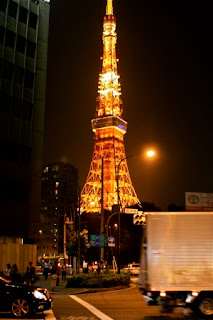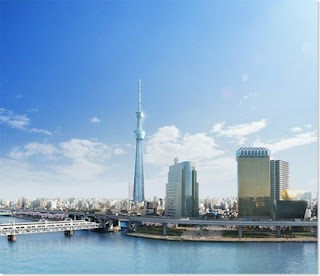The official name is Nippon Denpato Tokyo tower (Tower RadioJpenag waves) that are triggered by Hisakichi Maeda, a business newspaper in Osaka. This building is a steel tower bangungn the highest in the world with a height of 332.6 m. The overall In accordance with aviation safety regulations, or Tokyo Tower Tokyo Tower painted with international orange with white in some places. Lower surrounding buildings, so the Tokyo Tower can be seen from various locations in the city center.
The design of the tower following the Eiffel Tower in Paris, France. Although higher than the Eiffel Tower 8.6 m (32.6 m higher when a television antenna is also counted), Tokyo Tower only weighs 4200 tons compared to the Eiffel Tower weighs 7300 tons. The top of the tower is designed to withstand high winds blowing wind speeds up to 100 m per second, while the bottom of the tower withstand winds of up to 80 m per second.
The transmitter is placed at the Tokyo Tower can reach the Kanto region to a radius of 100 km. Before the Tokyo Tower was established, a number of TV stations in Tokyo, NHK General TV, Nippon Television (NTV), and TBS has been operating with its own transmitter antenna height of 170 m. In 1958, Fuji TV, NET (now TV Asahi), and the NHK educational channel started to move the transmitter antenna to the Tokyo Tower.
Mascot is the twin towers Noppon derived from the word "Noppo" (the height). Blue dress worn Noppon who was born first, while her sister wore a red shirt.
Tokyo Tower Japan's History
• April 1957 - Nippon Denpato Kabushikigaisha (PT Menara Radio Waves Japan) was founded.
• June 29, 1957 - Physical construction of the tower begins.
• October 14, 1958 - Construction of the tower that takes 1 year 3 months is completed.
• December 7, 1958 - Tokyo Tower opened to the public (experimental stage).
• December 23, 1958 - Tokyo Tower was officially opened to the public.
• January 10, 1959 - NHK Educational TV began broadcasting from Tokyo Tower.
• January 2, 1959 - NET (Japanese Educational Television, now TV Asahi) began broadcasting from Tokyo Tower.
• March 1, 1959 - Fuji TV began broadcasting from Tokyo Tower.
• April 1959 - NHK Educational TV transmitter was moved to the center of Tokyo Tower transmitter in the area Kioi. In contrast, NHK General TV transmitter was moved to Tokyo Tower.
• January 17, 1960 - TBS to move the transmitter from Akasaka headquarters to Tokyo Tower.
• 12 April 1964 - Division of Nihon Kagaku Gijutsu Shinko Television began broadcasting Zaidan (now called TV Tokyo).
• 26 April 1970 - Tokyo FM began broadcasting.
• 10 November 1970 - Nippon Television's transmitter was moved to Tokyo Tower.
• 1980 - NHK Educational TV transmitter was moved back to Tokyo Tower, so the transmitter tower accommodates all TV stations in the city of Tokyo.
• 1 November 1984 - Television and FM radio belongs to the University of the Air began broadcasting.
• October 1, 1988 - Japan FM (now J-Wave) began broadcasting.
• 1 November 1995 - Tokyo MX TV stations began broadcasting.
• 1 April 1996 - InterFM Radio began broadcasting.
• December 1, 2003 - All TV stations in addition to the University of the Air began broadcasting with a digital system.
• December 1, 2006 - University of the Air began broadcasting digital TV.









{ 0 comments... read them below or add one }
Post a Comment